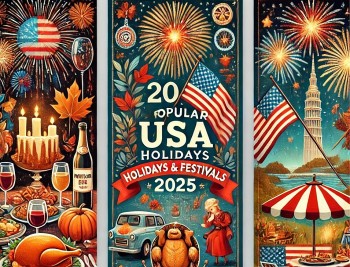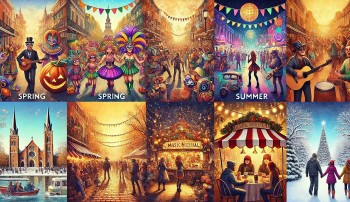American Unique Festival: Bigger, Bolder, and Brighter
 Top 10 Biggest Beverage Tradeshows & Festivals in the U.S. for 2025 Top 10 Biggest Beverage Tradeshows & Festivals in the U.S. for 2025 |
 10 Biggest Holidays and Festivals in Canada 2025 10 Biggest Holidays and Festivals in Canada 2025 |
Festivals are universal expressions of culture, bringing people together through shared traditions, art, and celebration. Yet, the festivals in the United States stand out for their diversity, scale, and cultural integration. From iconic parades to world-renowned music festivals, U.S. celebrations showcase a dynamic blend of historical significance, modern creativity, and multicultural influences.
Cultural Diversity: A Melting Pot of Traditions
 |
| What Makes U.S. Festivals Unique Compared to Other Countries |
The United States is often called a melting pot, home to people from virtually every corner of the world. This diversity profoundly shapes the country’s festivals.
How It’s Unique:
- Multicultural Celebrations: Festivals like Chinese New Year in San Francisco, Diwali in Houston, and Cinco de Mayo in Los Angeles highlight global traditions adapted to the U.S. context.
- Blending of Cultures: Events like the Hawaiian Aloha Festivals incorporate both Native Hawaiian traditions and Western influences, creating unique celebrations.
- Universal Participation: Even festivals tied to specific communities, such as Juneteenth or Pride Parades, often attract nationwide participation and solidarity.
Comparison:
While countries like India or Mexico may celebrate specific cultural festivals with deep local roots, the U.S. transforms these into inclusive events where people of all backgrounds come together to celebrate.
Scale and Spectacle: Bigger, Bolder, Brighter
American festivals are known for their grandiosity. Whether it’s a small-town fair or a major national event, U.S. celebrations are characterized by larger-than-life elements.
How It’s Unique:
- Massive Parades: The Macy’s Thanksgiving Day Parade in New York features towering balloons, elaborate floats, and performances broadcast worldwide.
- Firework Displays: Independence Day celebrations across the U.S. showcase some of the most extravagant fireworks displays, with cities like Washington D.C. and Boston leading the way.
- Music Festivals: Events like Coachella and Lollapalooza attract global artists and audiences, blending music, fashion, and art into multi-day experiences.
Comparison:
While other countries host grand festivals like Brazil’s Carnival or China’s Spring Festival, U.S. events often emphasize mass appeal and technological spectacle, incorporating Hollywood-style entertainment and global stars.
Integration of Commercial and Community Aspects
Festivals in the U.S. often strike a balance between community traditions and commercial sponsorships, making them accessible while fostering economic growth.
How It’s Unique:
- Corporate Involvement: Events like the Super Bowl Halftime Show or New Year’s Eve in Times Square are heavily supported by brands, creating high-quality productions that are free for the public.
- Community Roots: Despite corporate sponsorship, many festivals, such as local county fairs or the Albuquerque International Balloon Fiesta, retain strong community involvement.
- Fundraising and Causes: Many U.S. festivals incorporate charity runs, auctions, or awareness campaigns, combining fun with philanthropy.
Comparison:
In contrast, festivals in countries like Japan or France often focus more on traditional rituals and cultural preservation, with less emphasis on commercialization.
Historical Context and Evolution
American festivals often have historical origins but are reimagined to suit modern sensibilities, creating events that feel both nostalgic and contemporary.
How It’s Unique:
- Thanksgiving: Rooted in a 17th-century harvest celebration, Thanksgiving has evolved into a family-centered holiday with a focus on gratitude and food.
- Juneteenth: Once a regional commemoration of emancipation, it is now a nationally recognized holiday celebrating African American freedom and culture.
- Halloween: What began as a Celtic pagan tradition is now a billion-dollar industry involving costumes, haunted attractions, and family-friendly events.
Comparison:
While festivals like India’s Diwali or Spain’s La Tomatina maintain traditional forms, U.S. festivals are often reinvented to stay relevant to modern audiences.
Accessibility and Inclusivity
One of the most defining traits of U.S. festivals is their openness to all. Regardless of background, anyone can participate in most American celebrations.
How It’s Unique:
- National Holidays with Universal Appeal: Independence Day, Memorial Day, and Labor Day are celebrated by all Americans, regardless of ethnicity or religion.
- Open Participation: Events like Pride Parades or Music Festivals welcome attendees from all walks of life, fostering a sense of community.
- Digital Access: Live-streamed events, such as the Academy Awards or New Year’s Eve at Times Square, bring celebrations to a global audience.
Comparison:
Festivals in other countries, such as Japan’s Gion Matsuri or Germany’s Oktoberfest, may have a more regional or cultural focus, limiting participation to those familiar with specific traditions.
Focus on Entertainment and Innovation
American festivals prioritize entertainment and innovation, blending cutting-edge technology with live performances and interactive elements.
How It’s Unique:
- Virtual Reality and Tech Integration: Festivals like South by Southwest (SXSW) incorporate VR, AI, and emerging technologies, making them hubs of innovation.
- Interactive Experiences: Events like Burning Man encourage attendees to become part of the art and performance, breaking the barrier between audience and artist.
- Celebrity Culture: Hollywood’s influence ensures that festivals often feature appearances by celebrities, adding glamour to the events.
Comparison:
While festivals like the Venice Carnival or India’s Pushkar Fair focus more on tradition and art, U.S. festivals emphasize entertainment that appeals to global audiences.
Wide Variety of Themes
From niche interests to major cultural movements, U.S. festivals cater to every possible interest, creating an unmatched diversity of themes.
Examples:
- Comic-Con International (San Diego): Celebrating pop culture, comics, and movies.
- Barbecue Festivals (Kansas City, Memphis): Honoring America’s love for food and grilling.
- Jazz and Blues Festivals (New Orleans): Paying homage to musical roots and cultural heritage.
- Alien Fest (Roswell, New Mexico): A quirky event for UFO enthusiasts.
Comparison:
Countries like Italy or Thailand may have fewer themed festivals, focusing more on religious or historic events.
Conclusion: The Uniqueness of U.S. Festivals
What makes U.S. festivals truly unique is their ability to blend diversity, innovation, and accessibility. They are more than just celebrations—they are reflections of the nation’s identity, history, and creativity. By embracing inclusivity, pushing the boundaries of entertainment, and welcoming influences from around the globe, U.S. festivals set a standard that few other countries can match.
Whether it’s the awe-inspiring spectacle of Macy’s Thanksgiving Day Parade, the cultural richness of Juneteenth, or the futuristic creativity of Burning Man, U.S. festivals continue to captivate locals and visitors alike. They are not just events—they are experiences that define what it means to celebrate in the modern world.
FAQs
1. What makes U.S. festivals different from those in other countries?
U.S. festivals are known for their inclusivity, scale, and diversity, often blending global traditions with local creativity.
2. Are U.S. festivals accessible to international visitors?
Yes! Many festivals, like Coachella or Halloween, attract global participants and are easy for tourists to enjoy.
3. How are U.S. festivals influenced by other cultures?
The U.S. is a multicultural society, so many festivals, such as Chinese New Year or Diwali, adapt traditions from immigrant communities while inviting broader participation.
4. What are some iconic U.S. festivals to attend?
Must-see festivals include the Macy’s Thanksgiving Day Parade, Burning Man, Mardi Gras, and South by Southwest.
5. How do U.S. festivals contribute to the economy?
Festivals drive significant economic activity through tourism, hospitality, retail, and entertainment, benefiting local and national economies alike.
 Top 20 Most Popular Holidays and Festivals Around the World in 2025 Top 20 Most Popular Holidays and Festivals Around the World in 2025 KnowInsiders present the top 20 holidays and festivals celebrated worldwide in 2025, based on their popularity, cultural significance, scale, and global reach. |
 Top 20 Most Popular Holidays and Festivals in the US 2025 Top 20 Most Popular Holidays and Festivals in the US 2025 We look at the top 20 most popular holidays and festivals expected to bring millions together in 2025. |
 Top 10 Biggest Music Festivals in the U.S. 2025: The Ultimate Guide Top 10 Biggest Music Festivals in the U.S. 2025: The Ultimate Guide This guide covers the top 10 largest and most popular music festivals in the U.S., highlighting details on expected attendance, key highlights, and essential travel ... |
 Full List of Festivals in the US for 2025: Music, Food, Art, Film, Street and More Full List of Festivals in the US for 2025: Music, Food, Art, Film, Street and More From coast to coast, the United States is home to a dynamic array of festivals in 2025 that celebrate music, food, art, literature, technology, history, ... |
























